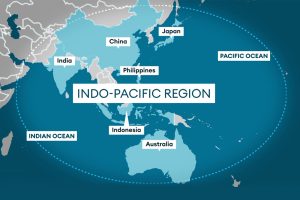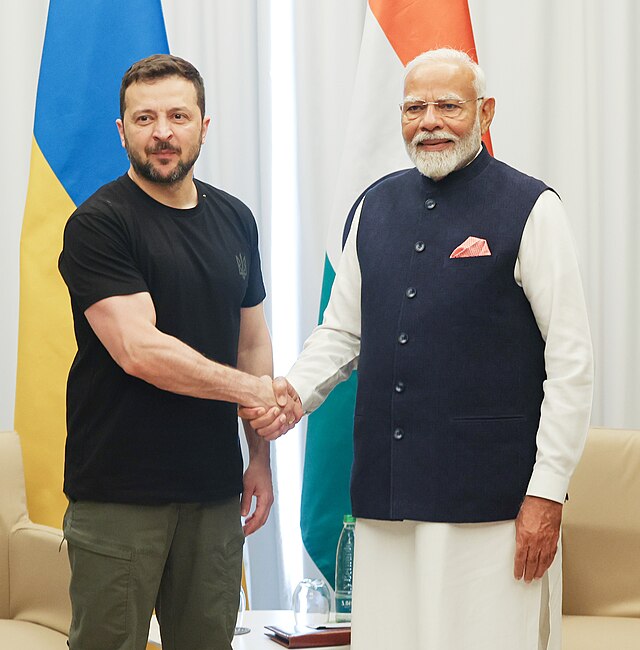
Indo-Pacific : Scramble For Dominance And Role Of Air Power

In the New World Order, Indo-Pacific is emerging as a strategically integrated arena of competition and cooperation. The rise of China; beyond the South China Sea, across the Indian and Pacific Oceans, challenges the security umbrella strategically established at the end of Second World War. The Indo-Pacific, representing the new strategic reality of the twenty-first century, is emerging as a new geographic space, bringing together the Indian and the Pacific Oceans. Due to the strategic dominance of the area, there has been a steady increase in number of stake holders and their “push” for enlarging their area of influence through diplomatic, economic, and military means. In the recent years, the race for dominance between emerging power China and the established superpower United States has led to large number of new alliances of different stake holders to claim their regional control and share. India in Indian Ocean with Australia and Japan in Pacific Ocean being the next three major stake holders, were the natural choice for the Quadrilateral Security Dialogue or the QUAD with the US.
Developing Strategic Situation in Indo-Pacific Region
China’s continued ascendance in extending its maritime influence in the Indo-pacific region raised alarm for various nations affected; directly or indirectly, by the turn of events in this otherwise peaceful marine zone. India’s concern was mainly with incessant Chinese naval activities in the Indian Ocean coupled with territorial disputes with China and their growing nexus with Pakistan. Japan, on its part was concerned about China’s incursions into and around the disputed Senkaku islands along with militarisation of the South China Sea. Australia was anxious about Chinese influence increasing in the internal politics of their country, China making inroads into the capital market to buy Australian companies as well as China’s military build-up in the SCS. Washington, with singular dominance over the region, was becoming increasingly worried about the China’s expansion in Indo-Pacific region to challenge the regional balance; both economically and militarily. Since India is an important strategic partner, while Australia and Japan are treaty allies, working closely with these countries for strategic goals on a common platform like QUAD, was natural for the United States.

The strategic and economic significance of the Indo-Pacific cannot be emphasized enough in the current international relations. The growing importance of the Indian Ocean as a geo-economic and geo-political nerve centre along with being the most significant trade corridor, where one-third of bulk cargo and almost two-thirds of global oil transit. China has significantly expanded its prowess in the Indian Ocean Region (IOR) over the past three decades. It is raising fears among the strategists of US and India, that the growing naval presence of China along with its use of so-called “debt-trap diplomacy,” might give her an edge in the contested region. The strategic bottlenecks in the IOR have been monopolised by way of investing in geo-economically important ports from Sudan to Hong Kong.
Force Induction and Military Balance in Indo-Pacific
As of 2021, heads of state of all four member nations of QUAD have stepped up their efforts to work on shared strategy on concerns about China’s increasingly assertiveness in the region and are more aligned to formulate a constructive plan of economic and military cooperation. The initial plan of maritime cooperation among the QUAD members, that began after the Boxer tsunami of 2004, has now widened its scope, covering far more issues, that include concerns in the field of security, economic growth, and health. These concerns have mostly emerged in the light of China’s expansion plans in SCS and post pandemic economic slowdown faced by most of the nations across the globe. The vision paper of the People’s Republic of China (PRC) on “China’s National Defence in the New Era”, published in July 2019, clearly indicated the intent of China in establishing its supremacy in SCS. In the vision document, China has, without any ambiguity, defined its objective that would safeguard its maritime rights, overseas interests as well as oppose and contain “Taiwan independence”. The struggle for control within the IOR is experiencing a notable change, as nations from outside the region have begun to establish a permanent presence in the zone. In the last decade, China has sharply escalated its maritime presence in the Indian Ocean, with activities like hydrographic surveys in the Exclusive Economic Zones (EEZ), increasing of submarines deployment, underwater drones and creation of establishment in Djibouti for overseas military activities. China, in early 2020, having built strong military capability in all domains including cyber, space and maritime since 2013, surged forward to meet the objectives of its vision document 2019, while the entire world was gripped by the unprecedented spread of Corona pandemic.
PLAN and PLAAF
People’s Liberation Army Navy (PLAN) and People’s Liberation Army Air Force (PLAAF) are the arms of PLA that are being deployed across the SCS and parts of Indo-Pacific Maritime Zone (IPMZ) to assert and claim dominance in the region. To secure its claim on worldwide trade and create opportunity to exploit vital resources, Beijing is quickly building its military’s offensive and protective powers within the Indo-Pacific environment and extending it blue water maritime capability. There has been a substantial increase in the number of submarines by China, for offensive patrolling and security of its Sea Lines of Communications (SLOCs). In the current situation, PLAN has deployed multiple types of submarines of Shang I-class, attack submarines of Shang II-class as well as Jin-class. A large number of destroyers, frigates and corvette form the cohesive Carrier Battle Group (CBG) to undertake offensive patrolling and protect the aircraft carriers. The PLAAF also has dedicated a large portion of its strength of about 1600 combat worthy aircrafts that include primarily Su-27s and Su-30s with few J-11s. In the near future Su-35s are also likely to dominate the skies over SCS. However, there is a critical limitation of Chinese aircrafts lacking the much needed engine capability for long hours of continuous operations. This limitation, coupled with limited aircraft carriers and shortage of Flight Refuelling Aircrafts (FRAs), poses a serious challenge to PLAAF and PLAN towards achieving their dominance of skies against technologically advanced, carrier and shore based fighter jets of US and allied forces. It is estimated that PLA’s strategic airlift requirement in the entire IPMZ could be as high as 130 to 150 heavy lift aircrafts. The shortage of FRA and heavy lift capability is likely to complicate the issue further. The H-6 family of strategic bombers even with recent upgrade to the H-6K, avionics and weapon carriage modernisation, are no match to the B-52 type strategic bomber on the US inventory, that carry almost six times the payload of H-6K and have most modern avionics integrated with various defensive systems.
US Forces
Indo-Pacific region is looked after and dominated by United States Indo-Pacific Command (USINDOPACOM) of the United States Armed Forces. It is the largest US strategic command with almost 2,000 aircraft, three CBGs; 200 plus ships and submarines operating at any time in the zone. Pacific Air Forces (PACAF), with a large number of fighters, Bombers and High Value Air Assets (HVAAs), constitute a vital portion of the command. With an unmatched fleet of about 12 operational aircraft carriers, nearly 300 battleworthy ships of destroyer, frigate class with compliment of huge tankers, amphibious ships and support ships, the US Navy can always boast itself to be a global strategic projection force. The US Navy also has about 75 submarines. PACAF has 334 fixed wing aircraft that include mainly fighters like F-15C/D Eagle, F-16CJ/DJ, heavy lift aircrafts, AWACS and FRAs. USAF inventory in PACAF also include F-35, F-22A Raptor, C-17 Globemaster III, C-130 among many others. B-52 bombers with long range and precision weapon delivery capability would continue to play the dominant role in the skies over the Indo-Pacific.
India
Indian Navy (IN) presently has two aircraft carriers along with 137 ships and submarines, and 290 aircraft. IN also has a reasonable strength of about 20 submarines. The Indian Air Force (IAF) is formidable and highly capable force with more than 1800 aircraft, state of the art technology weapons, supported by a secure robust AD network. IAF has a large inventory of fighters, that include Rafale, Su-30MKI, MiG-29UPG, Mirage 2000 and indigenous LCA. HVAAs like AWACs, AEW&C, IL-78 FRAs with heavy airlift aircrafts including C-17 Globemaster, C-130, IL-76 and Chinook helicopters give an envious capability to IAF in the IOR along with a large variety of helicopters like Mi-17, Mi-17 1V, Mi-17V 5, Light Combat Helicopters (LCH) and Rudra. Heron, Searcher UAVs with Unmanned Combat Aerial Vehicle (UCAV) Harpy give an edge to IAF for search and strike capability.
Balance Rests on Air Power
The historical development of military power by each nation would play a crucial role in its ascendency on the global map as a reckonable force. China, historically had been a land based military power with minimal naval forces on the Eastern province. However, with changing times, China gradually not only developed its military might in the domains of Air and Marine, but also rapidly altered its vision document to expand its prowess in cyber, space and nuclear domains also. There are a large number of factors that would decide the tilt of balance of Air power supremacy towards QUAD alliance and would serve as the decisive factor in this power struggle in the Indo-Pacific region.
Numerical Disparity
A huge disparity exists between the US and China, in terms of the number of fighters, heavy lift, AWACS, AAR aircraft as well as helicopters and UAVs along with reconnaissance aircraft. The disparity is not only in terms of shore-based assets but also in terms of carrier-based aircraft as operating surface in the ocean.
Technological Disparity
A large number of aircraft and other airborne systems with PLAAF are of older vintage compared to that of USAF or PACAF. The disparity of technology is not in terms of aircraft alone but exists in all associated systems; be it radars, air guided munitions or secure communication systems.
- Airlift Capability. China has very limited airlift capability compared to USAF; be it of fixed wing or helicopters. Lack of such capability, that acts as a force multiplier, can always prove critical in military engagements.
- Long Range Reconnaissance. In order to win the battle over sea, aerial reconnaissance plays a vital role in terms of providing timely and accurate early warning. The present reconnaissance capability of PLAAF is limited not only in terms of range but also in endurance and reach. US, on the other hand possesses a very high degree of capability in this domain.
- Precision Weapons. PLAN and PLAAF have a very limited capability of Precision Guided Munitions (PGMs) as well as delivery platforms. Almost all US Navy carrier based aircraft have this capability. Such a disparity would put PLAN at a disadvantage vis-à-vis US Navy.
Conclusion
Indo-Pacific has emerged as one of the most volatile conflict zones of the world. China is focused on securing regional dominance through building a networked, precision-strike capability. Thus, while on one hand, China is exerting its dominance over key maritime sectors of IPMZ, on the other, Southeast Asian countries, Japan, India, Australia and the US are determined to ensure an inclusive, rule-based international order in the region that allows level playing field for equal, free and open trade opportunities for all the stakeholders.
In the quest for attaining avenues for economic growth, the power struggle between different ideologies is unavoidable. The increasing level of military presence both by US along with its allies and China is bound to lead to skirmishes at sea. Even with disproportionate naval assets, US and allies may find it difficult to establish clear supremacy of QUAD. The air power asymmetry would prove itself to be the winning factor in establishing stable international order in the region. The balance of air power in both, quantity and quality, is significantly in favour of the QUAD countries vis-à-vis China.
Disclaimer
The opinions expressed in this article are the author’s own and do not reflect the views of Chanakya Forum. All information provided in this article including timeliness, completeness, accuracy, suitability or validity of information referenced therein, is the sole responsibility of the author. www.chanakyaforum.com does not assume any responsibility for the same.
Chanakya Forum is now on . Click here to join our channel (@ChanakyaForum) and stay updated with the latest headlines and articles.
Important
We work round the clock to bring you the finest articles and updates from around the world. There is a team that works tirelessly to ensure that you have a seamless reading experience. But all this costs money. Please support us so that we keep doing what we do best. Happy Reading
Support Us





















POST COMMENTS (1)
Kalidan Singh